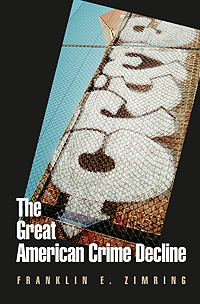Berkeleyan
What has to go right for a crime wave not to happen?
Great strides can be taken by cities willing to 'tinker around the edges' of policing and policy, says Boalt Hall professor
![]()
| 21 February 2007
Remember those unsettling crime forecasts for the 1990s? Leading policy experts and law-enforcement officials cautioned that changing demographics would create a swell in the nation's youth and young-adult populations, resulting in a dangerous crime wave of "super-predators."
 |
Not only didn't that crime wave occur, the opposite happened: According to new research by Franklin Zimring, a Berkeley law professor, the crime rate dropped dramatically during the 1990s, falling 40 percent in cities and states across the country and in all major crime categories from homicides to auto thefts, producing the longest and deepest crime decline in the United States since World War II.
In his new book, The Great American Crime Decline (Oxford University Press, 2007), Zimring points out that while there are no easy, clear explanations for this unexpected drop, the size of the decline provides instructive lessons for policymakers and law-enforcement officials grappling with today's toughest violent-crime problems.
Zimring's research suggests that the nation's crime rate - which has leveled off and remained flat since the year 2000 - could drop further, and that such significant declines in crime can happen without big changes in population and without substantial improvements to the nation's urban environment.
What didn't change - not what did
The case in point is New York City, which seemed locked in a violent-crime epidemic throughout the 1980s. However, from 1991 through 2004, the city's crime rate for serious offenses dropped about 75 percent - almost twice the national average.
"The most remarkable part of this story," Zimring writes in his book, "is not what changed in New York City over the 1990s, but what did not change, which was most of the city of New York. There were clever programs to stop fare avoidance in the subway system, but the subways didn't change, nor did the schools, the streets and surface-transportation systems, the population, or the economy."
Part of the drop came from relatively modest improvements in policing, says Zimring. The New York City Police Department increased its workforce by 35 percent, or 13,000 people - roughly the size of many of the nation's biggest city police departments in 1990. It also engaged in more aggressive policing, such as making stops that were independent of arrests and establishing a misdemeanor-arrest program for drug and other public-order offenses. And it changed its management style, objectives, and techniques, including placing more officers out on patrol.
"Even if only 25 to 50 percent of the total New York [City] drop was police-related, the big news from [there] is that we don't have to change the fundamental condition of modern urban life or the population," says Zimring. "We just have to find the right combination of ingredients in urban design, prevention, and policing, and that may be different for different cities. You just have to tinker at the edges, and you can get amazing results."
Finding that right mix of ingredients could prove to be the hard part, he says, since cities and counties vary in geography, population, rates of handgun ownership, even local crime conditions.
Further, isolating a single factor as the cause for a decline in crime can be elusive. Zimring found multiple possible contributors to the decline - including unprecedented economic gains, favorable demographics (in terms of a drop in the high-risk population of teens to 29-year-olds), and an increase in incarceration - with no single factor playing a dominant role.
Limited tools for data analysis
Much of the great American crime decline could be a cyclical phenomenon, says Zimring, one unrelated to public-policy changes or new approaches to police work. It's difficult to know for certain, in part because the statistical data and analytical methods currently available to isolate the impact on crime trends of police work, incarceration rates, the economy, and other such factors are not strong. It is this lack of strong, reliable, analytical tools, Zimring believes, that caused experts to err in their predictions of a 1990s crime wave.
Still, Zimring contends, while 40 percent of New York City's 75 percent drop in crime reflects the same mix of factors that drove the national crime rate down 40 percent, much of the remaining 35 percent drop is almost certainly due to the three major changes in New York City policing: more police, better management, and more aggressive policing.
In New York City, the total drop has led to 1,600 fewer homicides per year. Even if police changes prevented only 25 percent of the total decline, Zimring points out, that would be more than one life saved every day.
Law-enforcement agencies elsewhere would do well to try a number of targeted policing approaches, tailoring them to their jurisdictions.
"Whatever else is known about crime in America," Zimring writes, "the most important lesson of the 1990s was that major changes in rates of crime can happen without major changes in the social fabric."

